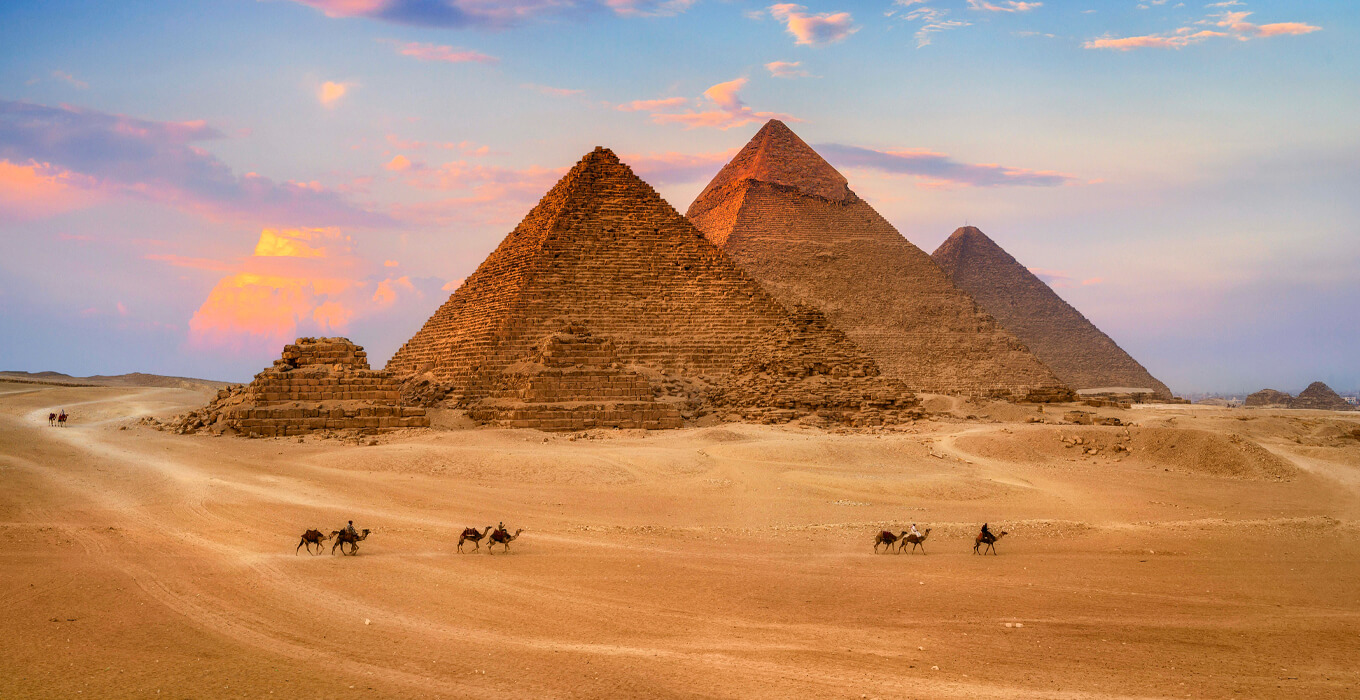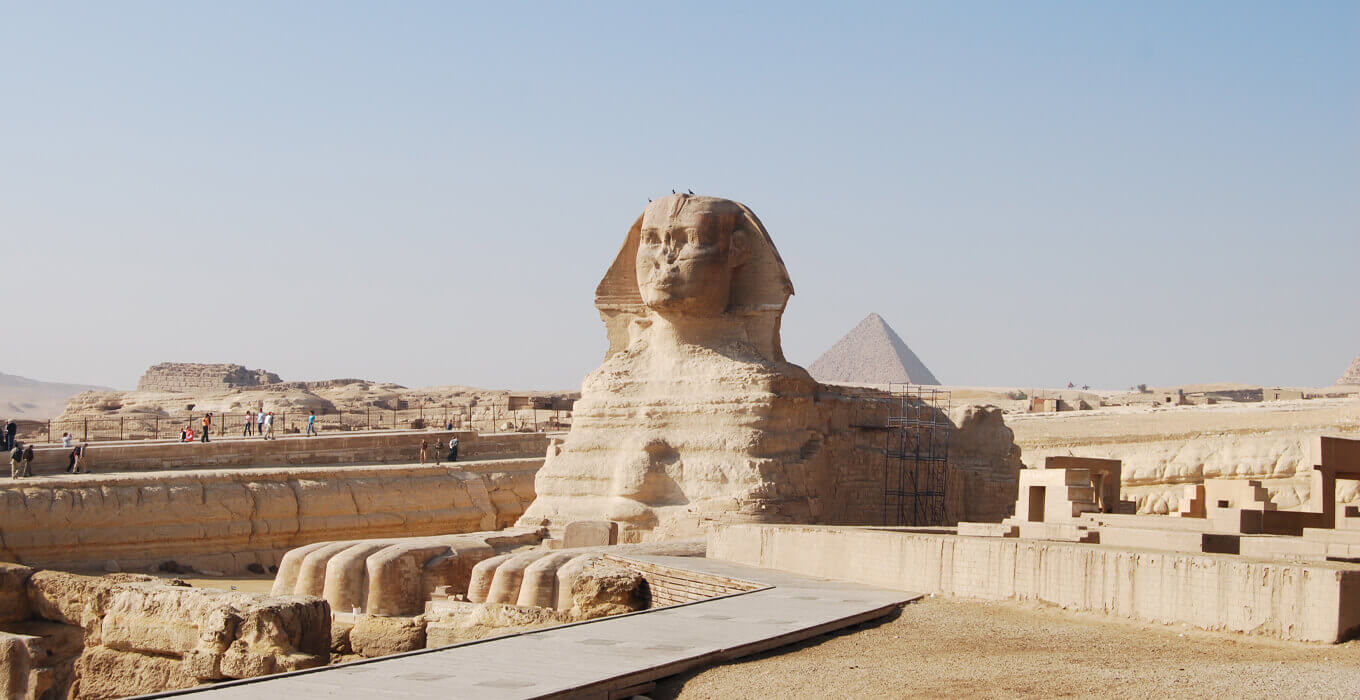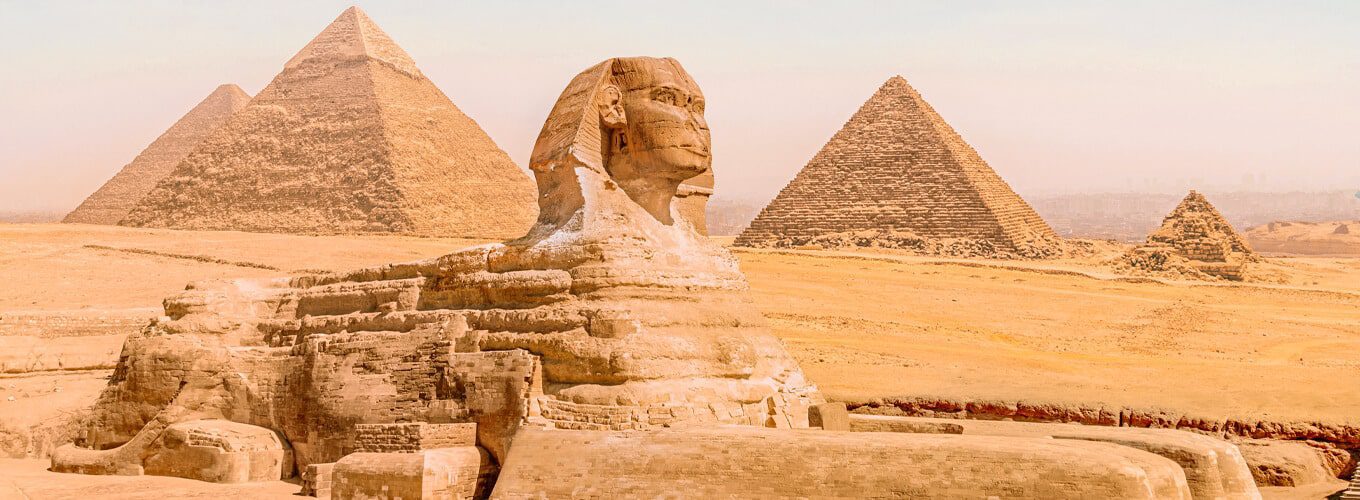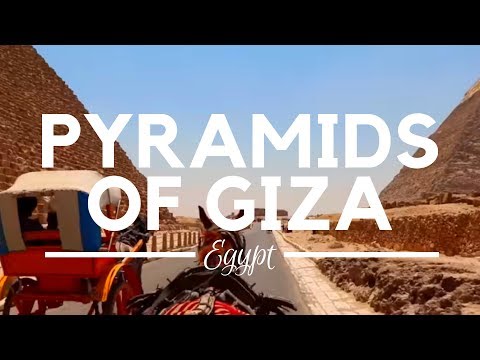Ever wondered what secrets the pyramids of Giza hold? This ancient Egyptian site is full of architectural and cultural wonders. It draws visitors from all over the world. The Great Pyramid of Khufu and the Great Sphinx are just the start of its marvels.
The Giza Necropolis is a UNESCO World Heritage Site and one of the Seven Wonders of the Ancient World. It takes you back in time. Here, you can uncover the mysteries that have puzzled historians and archaeologists for centuries. Let’s explore the ancient wonders of Giza together and discover the secrets of Egypt.
Find out more about Egypt with our related article: Discover Egypt
Key Takeaways
- The Giza Necropolis is home to the iconic Great Pyramids, including the largest and oldest, the Great Pyramid of Khufu.
- This ancient Egyptian site, dating back to the 4th dynasty, is a UNESCO World Heritage Site and one of the Seven Wonders of the Ancient World.
- Visitors can explore the grandeur of the Great Pyramid, the Pyramid of Khafre, the Pyramid of Menkaure, and the enigmatic Great Sphinx.
- The Giza Necropolis complex was built over approximately three thousand years, with structures dating mainly to the Old and Middle Kingdom periods.
- The site is a popular tourist destination, offering a unique opportunity to immerse oneself in the rich history and cultural significance of ancient Egypt.
Introduction to the Giza Necropolis
The Giza Necropolis is a fascinating site near Cairo, Egypt. It has the three big pyramids and the Great Sphinx. These were built in the 4th dynasty of the Old Kingdom. They show the amazing skills of ancient Egyptians in building.
Overview of the Ancient Egyptian Monuments
The Great Pyramid of Giza was made around 2550 BCE and was very tall. It was 481 feet high. Near it, there are two more pyramids built by Khufu’s followers.
There were also many tombs around for the royal family and important people. These were meant to be their homes forever.
Significance as a UNESCO World Heritage Site
The Giza Necropolis is a UNESCO World Heritage Site. This means it’s very important for its history and culture. It’s known for its amazing ancient Egyptian buildings. These sites draw people from all over the world.
The Great Pyramid of Khufu
The Great Pyramid of Khufu, also known as the Pyramid of Cheops, is the biggest and most famous of the three pyramids in Giza. It was built with over 2.3 million limestone blocks, each weighing about 2.5 tons. It is the only one of the Seven Wonders of the Ancient World still standing.
Architectural Marvel and One of the Seven Wonders of the Ancient World
The Great Pyramid amazed people with its huge size and amazing engineering. It was as tall as 146.6 meters (481 feet) and had a base of 230.33 meters (756 feet) on each side. It was the tallest man-made structure for over 3,800 years, showing the skill of ancient Egyptian builders.
Exploring the Interior Chambers and Grand Gallery
The inside of the Great Pyramid is full of mysteries. It has three main chambers: the lowest, the Queen’s Chamber, and the King’s Chamber. The Grand Gallery is a long passageway that leads to the King’s Chamber. It was where Pharaoh Khufu’s sarcophagus was kept.
| Architectural Details | Measurements |
| Coordinates | 29°58’45″N 31°08’03″E |
| Original Height | 146.6 meters (481 feet) |
| Current Height | 138.5 meters (454.4 feet) |
| Base | 230.33 meters (756 feet) |
| Volume | 2.6 million cubic meters (92 million cubic feet) |
| Estimated Blocks Used | 2.3 million |
| Weight of Blocks | 6 million tonnes |
| Slope of the Pyramid | 51°50’40” |
The Great Pyramid of Khufu shows the amazing skills of ancient Egyptian builders. It still amazes people today as one of the Seven Wonders of the Ancient World.
The Pyramid of Khafre
The Pyramid of Khafre is next to the Great Pyramid in the Giza Necropolis. It was made by Khafre, the son of Khufu. It stands 143.5 meters (471 feet) tall and has a beautiful outer casing of Tura limestone at the top.
It was built around 2570 BC during Khafre’s rule, from about 2570-2544 BCE. Even though it’s smaller than the Great Pyramid, it looks bigger because it’s higher up. The pyramid’s base is 215.25 meters (706 feet) wide and it has a huge volume of 2,211,096 cubic meters (78,084,118 cubic feet).
Thousands of skilled workers helped build the pyramid. They were organized by the ancient Egyptian state. Some of the original stones are still on the upper levels, showing how well it was made.
The pyramid is part of a big complex. It includes the Great Sphinx, a symbol of the sun, and a mortuary temple. The valley temple at the pyramid’s east end was made with huge blocks and had floors of polished white calcite.
Exploring the Pyramid of Khafre has given us new insights into ancient Egypt. A statue of Khafre found in the valley temple shows him on a lion throne. It has symbols of Upper and Lower Egypt, showing his power.
The Pyramid of Khafre is still amazing to visitors and scholars. It shows the grandeur and skill of ancient Egyptian civilization.
The Pyramid of Menkaure
The Pyramid of Menkaure is the smallest of the three big pyramids at Giza. It was built around 2510 BC during the 4th Dynasty of ancient Egypt. This structure, originally 65 meters (213 feet) tall, was the final home of pharaoh Menkaure.
Exploring the Queens’ Pyramids
At Giza Necropolis, there are smaller pyramids for the pharaoh’s queens too. These Queens’ Pyramids were key in ancient Egyptian funerals. They were where the pharaoh’s wives and royal family members were laid to rest.
The Valley Temple and Funerary Complex
The Menkaure Pyramid complex has a valley temple and a funerary complex. These were vital for ancient Egyptian rituals. The valley temple was made with huge limestone and granite blocks. It was where people entered the complex and was used for purification.

| Key Facts about the Pyramid of Menkaure | Details |
| Original Height | 65 meters (213 ft) or 125 cubits |
| Base Dimensions | 102.2 by 104.6 meters (335 ft × 343 ft) or 200 cubits |
| Volume | Approximately 235,183 cubic meters (8,305,409 cu ft) |
| Incline Angle | Approximately 51°20’25” |
| Sarcophagus Contents | Bones of a young woman |
| Coffin Radiocarbon Dating | 1212–846 BC, from the late New Kingdom to the Third Intermediate Period |
The Pyramid of Menkaure is smaller than the Great Pyramid of Khufu but still very important. It shows the amazing skills of ancient Egyptian builders.
The Great Sphinx of Giza
The Great Sphinx of Giza stands guard at the Giza Necropolis entrance. It has a lion’s body and a pharaoh’s head. People think it shows Khafre. This statue is 20 meters tall and 73 meters long. It symbolizes the king’s strength in ancient Egyptian myths.
Mythological Symbolism and Cultural Significance
The Great Sphinx of Giza is very important in myths and culture. It mixes a lion and a pharaoh’s head. This shows the king’s strength and wisdom.
For thousands of years, it has amazed people. It shows the skill and art of ancient Egyptians.
The Enigmatic Dream Stela of Tuthmosis IV
The Dream Stela of Tuthmosis IV adds to the Sphinx’s mystery. It’s a stone slab found near the Sphinx. The stela tells of a dream Tuthmosis IV had as a prince.
In the dream, the Sphinx spoke to him. It promised him the throne if he cleaned the Sphinx. This story makes the Sphinx even more special. It shows how much ancient Egyptians respected this figure.
Visiting the Giza Necropolis
The Giza Necropolis is a top spot for anyone wanting to see Egypt’s ancient wonders. You can get there from Cairo by joining a guided tour or getting private transport.
Getting to the Pyramids
Booking a tour is a great way to visit the Giza Necropolis. These tours come with round-trip transport, making it easy. Or, you can use Uber or Careem for a cheaper, flexible ride.
For more freedom, renting a car with a driver is an option. This lets you see the area at your own pace.
Best Time to Visit and Practical Tips
It’s best to go in the morning to avoid crowds and get great photos. Remember to dress for the heat and drink plenty of water. Tipping is common in Egypt, so keep that in mind.
Try to get there early, as tour buses start coming around 9:30 to 10:30 AM. This way, you’ll see the site with fewer people and beat the heat. Visiting in the off-peak winter season is also a good idea to avoid crowds.
“The Pyramids of Giza were built almost 5,000 years ago, and the Great Pyramid of Khufu remained the tallest building in the world for 3,800 years until 1311 AD.”
Whether you’re on a guided tour or going solo, planning and being ready will make your visit unforgettable.
Giza Necropolis
The Giza Necropolis is just 25 kilometers south of Cairo, Egypt. It shows the amazing skills of the ancient Egyptians. This place goes back to the 4th dynasty of the Old Kingdom, around 2580-2560 BCE.
Back then, the pyramids and other buildings were made as grand tombs for pharaohs. They were symbols of their power and their belief in an eternal life.
Historical Background and Archaeological Significance
The 4th dynasty is seen as the ‘golden age’ of the Old Kingdom. This is clear from the size and quality of the pyramids at Giza. The Giza Necropolis has six pyramids, including the famous Great Pyramid.
This pyramid is one of the Seven Wonders of the Ancient World still standing. Building it took 20,000 workers over 20 years. It’s a huge achievement in engineering and planning.
Over time, archaeologists have dug and studied the Giza Necropolis a lot. They’ve learned a lot about ancient Egypt’s architecture, culture, and beliefs. Experts have come up with different ideas on how the pyramids were built.
They think the pyramids might have used outside ramps, cranes, and internal ramps. French architect Jean-Pierre Houdin is one who has shared these ideas.
There’s more than just pyramids at the Giza Necropolis. You’ll find the Valley Temple and tombs of nobles too. The Sphinx, a huge statue with a human head and lion’s body, is also there.
It’s said to be from Pharaoh Khafra, around the mid-26th century BC. The Giza Necropolis draws in millions of visitors every year. It shows off the amazing history and architecture of ancient Egypt.
Cultural and Spiritual Importance
The Giza Necropolis and its pyramids are very important to ancient Egypt. They were symbols of the pharaohs’ power and divine status. They also showed the eternal journey of the soul into the afterlife.
The pyramids had funerary rituals and beliefs around them. These included preparing the dead, using certain artifacts, and connecting to the sun god Ra. These show the deep spiritual and cultural values of ancient Egyptian society.
The Pyramids as Symbols of Power and Eternity
The pyramids of Giza were more than big buildings. They were symbols of the pharaohs’ power and their connection to the divine. They were aligned with the sun and the directions, showing the pharaohs’ role as links between earth and heaven.
The pyramids’ timeless presence showed the eternal rule of the pharaohs and the promise of life after death.
Funerary Rituals and Ancient Egyptian Beliefs
- The elaborate funerary rituals were key to ancient Egyptian beliefs. They included mummifying the dead and giving them personal items for the afterlife.
- The Egyptians thought the soul, or ka, of the dead would live on. They needed to keep the body safe and give it what it needed for the afterlife.
- The spiritual connection to the sun god Ra was very important. The pyramids were built to match the sun’s path, helping the pharaohs become gods.
“The shape of the pyramids represents the divine unity, with the pyramid having 4 faces and being composed of 4 equilateral triangles that manifest the cosmic nature of God.”
The Giza Necropolis and its monuments still amaze us today. They are not just amazing buildings. They are lasting symbols of the rich cultural and spiritual heritage of ancient Egypt.

Preserving the Ancient Wonders
The Giza Necropolis is home to the famous pyramids and the mysterious Sphinx. It shows the amazing skills of ancient Egypt. But, keeping these ancient sites safe is a big challenge.
Conservation Efforts and Challenges
The Egyptian government and groups from around the world are working hard to keep the pyramids and Sphinx safe. They deal with problems like damage from nature, weather, and too many visitors. Preserving Ancient Wonders is very important. They must make sure people can visit and keep the sites safe for the future.
Even with these efforts, the Giza Necropolis faces big problems. These include buildings getting too close, pollution, and too many visitors. The area around the monuments is growing, which threatens their safety and future.
Responsible Tourism and Sustainable Practices
Responsible Tourism and Sustainable Practices are key to saving the Giza Necropolis. By controlling how many people visit and building new museums, they lessen the harm from tourism. The new Grand Egyptian Museum is also helping by making visits better while keeping the ancient sites safe.
The Giza Project is a big step forward. It’s a team effort to save the site’s artifacts, documents, and data. This digital archive helps scholars, researchers, and everyone learn about the Giza Necropolis. It’s a way to keep this history alive for the future.
| Preservation Efforts | Key Challenges | Sustainable Practices |
| ● Structural maintenance of pyramids and Sphinx
● Environmental conservation ● Visitor management strategies |
● Urban encroachment
● Pollution and weathering ● Increased tourist numbers |
● Construction of the Grand Egyptian Museum
● Digitization of archaeological data ● Collaborative preservation efforts |
Keeping the Giza Necropolis safe is a big task that needs many solutions. By focusing on Responsible Tourism, using Sustainable Practices, and keeping up with Conservation Efforts, Egypt and its partners hope to protect these famous sites for many years to come.
Conclusion
The Giza Necropolis is a place of wonder. It shows us the amazing skills, culture, and beliefs of ancient Egypt. It’s a UNESCO World Heritage Site that lets us dive into one of the most famous symbols of human greatness.
When we see the Giza Necropolis, we feel the power of the human spirit. The Great Pyramid of Khufu and the Sphinx show us the lasting impact of ancient Egypt. These wonders amaze and inspire people all over the world.
Keeping the Giza Necropolis safe for the future is very important. We must keep working on conservation and sustainable tourism. This way, we can keep learning from the ancient Egyptians. They left a big mark on our cultural heritage.
Don’t miss our related article:


